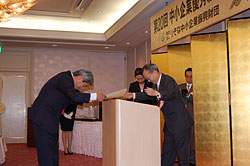News Release
Satake Cracked Grain Sorter Receives the Excellent New Product Award
April 14, 2008
April 14, 2008
Satake Cracked Grain Sorter Receives the Excellent New Product Award
The First Machine of its Kind Garners High Praise

The 20th Small and Medium Enterprise Excellent New Technology and Product Awards were held on April 11, 2008, at the Hotel Grand Palace in Tokyo, sponsored by the Resona Foundation for Small and Medium Enterprise Promotion and Nikkan Kogyo Shimbun, Ltd. Satake's Cracked Grain Sorter, a machine which optically detects cracks in brown rice, received the Excellent Product Award.
These awards are held to recognize new products, technologies and software rich in originality and marketability. They are held once a year to foster technology development in small and medium-sized domestic companies.
This year, the field was split into a Software Division and a Technology and Product Division. Thirty-four awards were given. Satake's Cracked Grain Sorter, a machine which optically detects cracks in brown rice, won the Excellent Product Award in the Technology and Product Division.
Shigeharu Kanemoto, Managing Executive Officer, Takafumi Ito, Group Manager of Development Group II, and Shigeki Kinoshita, also of Development Group II were present to accept the award.
As a rice plant grows, high temperatures or other adverse conditions can cause fractures to develop in the endosperm of the grain, resulting in cracked grains. These cracks reduce the quality level at shipment time, and at the rice milling plant cracked grains become broken grains, decreasing yield. Cracked grains are also a factor in flavor degradation at the consumer level.
The Cracked Grain Sorter uses original optical and high-speed image processing technology to recognize and remove cracked grains from brown rice at high speed. It is the first machine in the world with this capability.
The product was jointly developed in cooperation with the Western Industrial Technology Center of Hiroshima Prefectural Technology Research Institute in Kure City, and the Department of Electrical Engineering Graduate School of Advanced Sciences of Matter at Hiroshima University in Higashi-Hiroshima City.
* Please note descriptions in news releases are accurate as of the date of release and may differ from the most up-to-date information.
